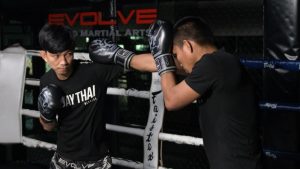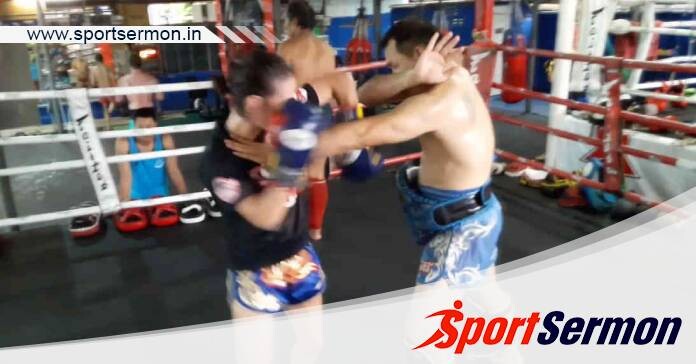Muay Thai Dracula Guard: In Muay Thai, you must be able to change your guard postures in response to your opponent’s attacking strategies. Variations can take the shape of subtle or significant changes to time-tested defensive positions, as is the case with the Dracula guard, a variation of the long guard.
The popular long guard posture was being breached by forceful up-the-middle attacks throughout the Golden Era, making it impossible to tell who named this guard or initially employed this variant.
During this period, aggressive fighters and technique experts who delivered as much harm as possible ruled the ring. The number of stitches was one of the statistics used to gauge the severity of the penalty, necessitating revisions to defensive guards that had previously been tried and tested. Due to the lengthy guard, it became necessary to adopt defensive strategies to prevent opponents’ heads from being knocked off by elbows or uppercuts.v
The Dracula guard can be employed to protect against a combatant who is aggressive, despite the fact that it is not impenetrable. However, as is the case with depending primarily on any one defensive motion, it is strongly advised to avoid utilising this guard throughout a battle against someone who can ultimately locate the gaps in it.
You might also be interested in reading this: Get To Know Everything About Body Lock In MMA
The Dracula Guard: Why Use It?
Muay Thai fighters must be prepared with a variety of defensive tools, such as guards to deflect kicks, knees, and elbows. But they do have weaknesses, just like all defensive guards do. Consider the fundamental Muay Thai shell guard.
Similar to the fundamental long guard, this basic guard stance creates a line through which uppercuts and elbows can pass. Because of the new angles fighters are adopting to attack their opponents, defensive guards sometimes require minor adjustments.
When the Muay Thai guard or long guard’s centerline is insufficient to defend your head and face, the Dracula guard is employed. From the Dracula guard posture, your head and chin are still shielded by the rear arm draped across the front of your face, even if your adversary pulls down your lead hand, comes over the top, or throws a left hook.
The back arm across your face is a nod to Dracula’s use of his cape to conceal himself in earlier Dracula films. You are shielded from inner elbows as well as outside elbows and punches by the back arm that is shielding your face. Keep your eyes up and focused on your opponent while keeping your chin tucked into your shoulder.
How To Apply Dracula Guard?

It is possible to defeat the Dracula guard from either the southpaw or traditional stance. The lead hand is held out straight in front of the body, the lead head is lowered with the chin pulled down, and the rear arm forms a ‘V’ with the rear hand resting on the lead shoulder. The back elbow acts as a protection for the chin in this situation. Similar to the long guard, the defensive manoeuvre, also known as the reverse shuffle, frequently includes a small lean back.
The efficiency of the Dracula guard might vary depending on the fighter’s skill level and the circumstances of the fight, but it can be a useful defensive tactic in a Muay Thai battle.
An easy explanation of how to enter the Dracula guard is provided below:
- A lengthy guard is formed with the lead hand outstretched.
- The rear hand touches the lead shoulder as the rear arm forms a ‘V’ shape around the face.
- Keep your chin tucked in under your back arm and your head down.
- Keep an eye on your opponent by keeping your gaze above your arm.
Defending Against The Dracula Guard
Being able to employ defensive techniques alone is insufficient in Muay Thai; you also need to be able to counter from your guard positions. The lead hand is utilised to judge the distance while countering out of the Dracula guard, exactly like it is in the long guard. You can hit someone if you can get close to them.
The ability to judge distance and the range of your offensive weapons is one that can be developed with time and practice. It will take some practice, but you may eventually become an expert at the defensive manoeuvre of seamlessly entering and exiting the Dracula guard while successfully counterattacking.
Rear Leg Knee Strikes
With your lead arm fully extended in the long guard posture, you may gauge distance from the Dracula guard and respond with a rear knee strike. You can deflect uppercuts, hooks, and straight punches thanks to the entire coverage. Furthermore, once they are thrown, your opponent leaves oneself vulnerable to a knee strike counterattack.
Leg Sweeps And The Dracula Guard Together
Leg sweeps and the Dracula guard can be combined. Remember that timing is crucial. If you can attack and counter at the right times, you’ll be in a better position to finish. One of the major components of creating a well-rounded game and what distinguishes a decent fighter from a great fighter is the ability to integrate both offensive and defensive.
Conclusion
The Dracula version overcomes some of the holes left by the long guard’s flaws, which can be exploited despite its efficiency. No defensive is impregnable, and the Dracula guard may leave you vulnerable to kicks, but you may exploit any gaps in your defence by blocking kicks or employing evasive manoeuvres that include moving backwards.
The Dracula Guard works through timing, technique, and countermeasures. Your overall combat plan will include understanding when to deploy each defensive and when to switch things up.
So this is a complete guide to Muay Thai Dracula Guard. Let us know your thoughts in the comment section below.

